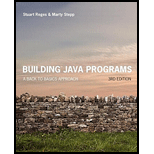Solutions for Building Java Programs: A Back To Basics Approach Plus Mylab Programming With Pearson Etext -- Access Card Package (4th Edition)
Browse All Chapters of This Textbook
Book Details
For courses in Java Programming
This package includes MyProgrammingLab™
Layered, Back-to-Basics Approach to Java Programming
Newly revised and updated, this Fourth Edition of Building Java Programs: A Back to Basics Approach uses a layered strategy to introduce Java programming, with the aim of overcoming the difficulty associated with introductory programming textbooks. The authors’ proven and class-tested “back to basics” approach introduces programming fundamentals first, with new syntax and concepts added over multiple chapters, and object-oriented programming discussed only once readers have developed a basic understanding of Java programming. Previous editions have established the text’s reputation as an excellent choice for thoroughly introducing the basics of computer science, and new material in the Fourth Edition incorporates concepts related to Java 8, functional programming, and image manipulation.
Sample Solutions for this Textbook
We offer sample solutions for Building Java Programs: A Back To Basics Approach Plus Mylab Programming With Pearson Etext -- Access Card Package (4th Edition) homework problems. See examples below:
More Editions of This Book
Corresponding editions of this textbook are also available below:
